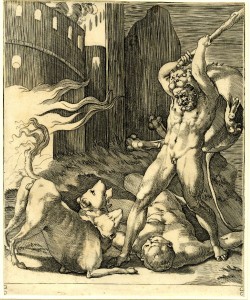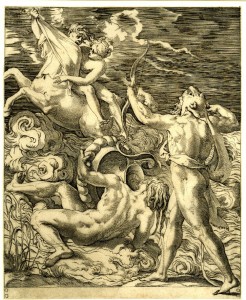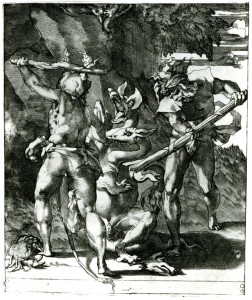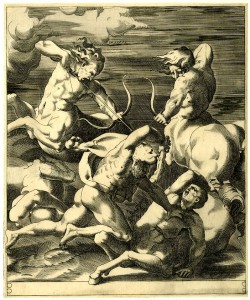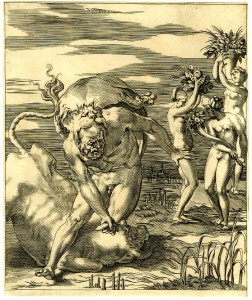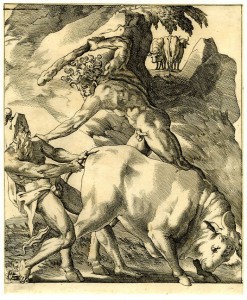Six engravings by Gian Jacopo Caraglio.
Three states:
I. Uninscribed.
II. Inscribed at lower right: Ant.Sal.excu.
III? Inscription removed but traces of it remain. Six impressions of this set in Braunschweig, nos. 3-8, showing the complete plate mark, are well printed from the worn plates on heavy paper. An impression of the same kind of the Cerberus (E.19) is in Berlin (209-18). The Cacus (E.24) of the Braunschweig set (no. 8) shows that at the time of its printing the upper edge at the left of the plate of this print had broken off. This is where all earlier impressions show a scar in the plate about 3.3 cm long and about 0.5 cm from the top line. However, this late set does not show the Salamanca address, although an impression of this print in Florence (1144ss) does. Consequently, it would seem that this address had been removed from the plate when the Braunschweig impressions were made. Traces of this address still need to be looked for. An impression of the Cerberus (E.19) in Rome may show such traces. This evidence suggests that there is a State III. These impressions could be those printed by Carlo Losi, in whose Roman inventory of 1788 they appear (see Massari, 1989, 13, n. 2, and 119). I have never seen an impression with his address, which does appear, however, on State IV of the Saturn of the Gods in Niches (Fig.E.26), with the date 1771.
Bartsch, XV, 1813, 85-86, 44-49, as Caraglio. Le Blanc, 1854-1890, I, 589, 49-54. Destailleur, 1895, 286, under no. 1157. Herbet, III, 1899, 48 (1969, 136).
E.19. Hercules Fighting Cerberus
22.2 x 18.3 S, including margin below of 0.9 (London).
Fig.E.19 (London)
Bartsch, XV, 1813, 85, 44.
COLLECTIONS: Berlin, 207-18 (II); 209-18 (see below); 210-18. Boston, Babcock 820; 5.871 (damaged). Braunschweig, no. 3 (III?). Edinburgh (weak, soiled). Florence, 1141ss; 1147ss (II). Florence, Marucelliana, Vol. IX, no. 27 (II). London, Vol. C53, Caraglio Volume, p.46 top. London, VA, Press I.2.C., no. 27877.1 (inscribed in ink in margin below: Del Rosso). Paris, Ba 12, p.28, top, no. 29; Eb 6b Rés. Providence, Museum of Art, Rhode Island School of Design, 67.080. Rome, Vol. 26 M 30, no. 05884 (III? inscription either removed from plate or scraped from impression). Vienna, H.B.IV, p.56, no. 79.
E.20. Hercules Shooting Nessus
22.2 x 17.5 L, including margin below of 0.9 (Edinburgh).
Fig.E.20 (London)
Bartsch, XV, 1813, 85, 45.
COLLECTIONS: Berlin, 208-18. Braunschweig, no. 4 (III?). Cambridge, Vol. 31.K.12, p.17, no. 40. Edinburgh. Florence, 1137ss; 1143ss (II). Florence, Marucelliana, Vol. IX, 28. London, Vol. C53, p.47 bottom (1866,0623.13). London, VA, Press I.2.C, no. 27887.2. New York, 47.100.797 (worn plate, inscribed in ink at lower right: . MAF . as a monogram. Oxford (very damaged). Paris, Ba 12, p.30 top, no. 63; Eb 6b Rés. Rome, Vol. 26 M 30, no. 05885, and no. 05886 (II). San Francisco (poor). Vienna, It.I.25, p.37 bottom (Oberhuber, 1966, 176, no. 295, Fig. 56).
E.21. Hercules Killing the Hydra
21.9 x 17.8 L, including margin below of 1.0 (London, VA); details of image overlap L.
Fig.E.21 (Vienna)
Bartsch, XV, 1813, 85-86, 46.
COLLECTIONS: Berlin, 199-18; 202-18 (worn plate). Bologna, Inv. C. 657 (446) (I). Braunschweig, no. 5 (III?). Edinburgh (wm., an anchor in a circle). Florence, 1140ss; 1146ss (II). Florence, Marucelliana, Vol. IX, no. 26. London, Vol. C53, p.47 top (1866.0623.14). London, VA, Press I.2.C., no. 27877.3 (inscribed in ink in margin below: Del Rosso and in margin in ink beneath the crab: cancer). Oxford (worn plate). Paris, Ba 12, p.30, bottom, no.64; Eb 6b Rés. Rome, Vol. 26 M 30, no. 05892?, and no. 05893 (both weak). Vienna, H.B.IV, p.57, upper left, no. 81.
E.22. Hercules Fighting the Centaurs
22.1 x 17.9 L, including margin below of 1.0 (London, VA).
Fig.E.22 (London, 1864,0611.441)
Bartsch, XV, 1813, 86, 47.
COLLECTIONS: Berlin, 200-18; 201-18 (very worn plate). Braunschweig, no. 6 (III?). Edinburgh, 2 impressions, the one mounted alone, weak, the other, mounted with E.21, good. Florence, 1136ss (trimmed on three sides, not on left); 1142ss (II). Florence, Marucelliana, Vol. IX, no. 30 (weak). London, 1866-6-23-15 (worn plate); 1864,0611.441. London, VA, Press I.2.C., no 27877.4 (inscribed in ink in margin below: Del Rosso). Paris, Arsenal, Vol. 168 (2), no. 58 (upper left corner missing and filled; see Schéfer below). Paris, Eb 6b Rés. Rome, Vol. 26 M 30, no. 123321 (very pale), nos. 05887 (pale) and 05888 (worn plate). Vienna, H.B.IV, p.57, upper right, no. 82.
E.23. Hercules Overpowering the River Achelous
22.2 x 17.7 L, including margin below of 1.0; 22.3 x 18.1 P (London, VA, E.86-9).
Fig.E.23 (London)
Bartsch, XV, 1813, 86, 48.
COLLECTIONS: Berlin, 204-18 (three corners missing, not upper right). Braunschweig, no. 7 (III?), and no. 12. Edinburgh. Florence, 1139ss (foxed); 1145ss (II). Florence, Marucelliana, Vol. IX, no. 29 (worn plate). London, Vol. C53, Caraglio Volume, p.48 top (1866,0623.16). London, VA, Press I.2.C., no. E.86-9 (inscribed in ink beneath plate mark at lower right: E.Sl.’91), and no. 27887.5 (pale); Press G.G.20, no. 12533 (in ink in margin at lower right: ANT.SAL.EXC.). New York, 49.50.208. Oxford (pale, stained). Paris, Ba 12 (spotted, lightly squared in black chalk or pencil); Eb 6b Rés. Rome, Vol. 26 M 30, nos. 05891 (squared) and 05892? (both pale). Vienna, It.I.25, p.39.
E.24. Hercules Fighting Cacus
22.2 x 17.9 L, including margin below of 1.2 (London, VA).
Fig.E.24 (London)
Bartsch, XV, 1813, 86, 49.
COLLECTIONS: Berlin, 205-18. Bologna, Inv. C. 655 (448) (I). Braunschweig, no. 8 (III?) and no. 12. Edinburgh. Florence, 1138ss; 1144ss (II). Florence, Marucelliana, Vol. IX, no. 25 (pale). London, Vol. C53, p.48, bottom (1866,0623.17). London, VA, Press I.2.C., no. 27877.6. New York, 49.50.208; 47.100.798 (worn plate, inscribed in ink at lower right: . MAF . as a monogram). Paris, Ba 12, p.29, bottom, no. 64; Eb 6b Rés. Rome, Vol. 26 M 30, nos. 05899 (weak) and 05890. Vienna, H.B.IV, p.57, no. 84.
LITERATURE:
Schéfer, 1894-1929, col. 554, no. 58.
Herbet, III, 1899, 38 (1969, 126).
Goldschmidt, 1911, 22. Voss, 1920, 187.
Pittaluga, 1928, 174.
Antal, 1928-1929 (1966, 54, 55-56, and n. 3, 73, 90, 91, ns. 1-2, Pl. 3a [Achelous]).
Kusenberg, 1931, 27, 162-163, Pl. XIX, 2 (Achelous, Paris, Eb 6b Rés), 3 (Cacus, Paris, Eb 6b Rés).
De Witt, 1938, 52.
Becherucci, 1944 (1949, 30).
Barocchi, 1950, 62, n. 1, 64.
Petrucci, 1964, 44-45, 14, Pl. 41 (Hercules Shooting Nessus).
Zerner, “Caraglio,” 1972, 692, and Vol. III, Pl. 219, 1-2, of Hercules Fighting Cerberus, discusses Caraglio’s technique where the strong plastic effect and elegant simplicity of Marcantonio’s style is joined by an animation of surface and the effects of light that seem very independent of the volumes in the print.
The most extensive account of these prints is by Campbell, in RISD, 1973, 75-79, nos. 80-85, where, however, he states without foundation that Baviera commissioned the designs of these prints in 1526. All of the illustrations of these scenes on pp. 76-79 are from a set of copies of Caraglio’s prints (see below).
Ferra and Gaeta Bertelà, 1975, nos. 161, 163 with Figs. (Hydra, Cacus, Bologna).
Borroni and Kozakiewicz, 1976, 616.
Sheard, 1978, nos. 95-97, with Figs. of Cerberus, Hydra, and Centaurs, as Caraglio, but all, however, copies of these prints (see below).
Barolsky, 1979 (1969), 14, 117, Fig. 112, recognized a drawing of a Reclining Male Nude in the Louvre (inv. no. 1518) that he gave to Daniele da Volterra as related to the river god in the Hercules Shooting Nessus [which I would think was based on a posed model and the resemblance accidental, especially as the left arm and leg are differently placed].
Borea, 1979, 368, Fig. 243 (Florence), ca. 1526.
Borea, 1980, 228, Fig. (Nessus, Paris), 230, 234, 248, nos. 611-616 (Florence and Paris), 228, Fig. of Hercules Shooting Nessus (Paris, Eb 6b Rés.).
Darragon, 1983, Fig. 15, as ca. 1525.
Carroll, 1987, 11, 24, 40, 75-86, nos. 9-14, with Figs. (Cerberus, London; Nessus, Paris, Eb 6b Rés.; Hydra, Vienna; Centaurs, Edinburgh; Achelous, London; Cacus, Paris, Eb 6b Rés.), as done after the Fury at the end of 1524.
Andrew Stephens, in The World in Miniature Engravings by the German Little Masters 1500-1550, Edited by Stephen H. Goddard, Spencer Museum of Art, University of Kansas, Lawrence, 113, suggests that Caraglio’s engravings may have provided the model for Sebald Beham’s Labors of Hercules, 1542 – c.1545, but far from being slavish copies such as Jacob Binck’s copies of Caraglio’s Gods in Niches.
Massari, 1989, 117, 119.
Carroll, 1989, 9, 12-13, Fig. 18 (Cerberus, London) Fig. 19 (Hydra, Vienna), Fig. 20 (Centaurs, Edinburgh), Fig. 21 (Achelous, London), Fig. 22 (Cacus, Paris, Eb 6b Rés.), Fig. 23 (Nessus, Paris, Eb 6b Rés).
Ciardi and Mugnaini, 1991, 18, the Hercules Fighting the Centaurs reflecting Leonardo’s Battle of Anghiari.
Vallone, 1993, 71, 77, n. 71, the scenes related to those of a Hercules sarcophagus on a Roman altar, with reference to Bober and Rubinstein, 1986, 170-171, nos. 134 and 135, with illustrations, and to an anonymous Raphaelesque work at the Vatican.
Franklin, 1994, 134-137, 138, Pl. 104 (Nessus, London), 172, Pl. 135 (Cacus, London), the proportions of the male and female figures perhaps an attempt to establish a different canon from those of Michelangelo and Raphael.
Ciardi, 1994, 81, 94, 110, mentioned their sensuality and noted that the Centaurs composition is related to the central group in Leonardo’s Battle of Anghiari.
Mugnaini, 1994, 119, Mugnaini, in Rosso e Volterra, 1994, 152-154, nos. 5-10 (Rome, the Nessus with the Salamanca address in lower margin, the others without lower margins), as probably executed at the end of 1525, the Centaurs recalling the Moses and taken up again at Fontainebleau, the elegant Hesperides in the Achelous anticipating the caryatids in the Gallery of Francis I.
These six engravings have always been recognized as by Caraglio after Rosso’s designs as indicated by Vasari, who specifies each one of them in his account of the career of this engraver. Vasari places them immediately after the Fury (Fig.E.18a), which seems to have been designed and engraved in 1524 very soon after Rosso arrived in Rome, but perhaps only after the failure of the Cesi Chapel commission. Stylistically on Rosso’s part, and technically on Caraglio’s, the Labors of Hercules appear to be later than the Fury. These scenes would seem to follow only shortly thereafter, following probably immediately upon Rosso’s stylistically similar St. Roch drawings of mid-1524 (Fig.D.13). The prints reveal an energetic response to the Roman and “pagan” artistic milieu that will be even more sophisticatedly explored in the other, and later, engravings that Rosso designed in Rome. It is likely that the Labors of Hercules were designed and engraved in the second half of 1524, and before the Dead Christ in Boston (Fig.P.18a) of 1525 or 1526. The margins beneath the scenes, suggesting attached tablets, may have been intended to receive inscriptions.
COPIES, PRINTS: Anonymous, E.113, 1 – 6, six engravings, same dimensions as the originals (Fig.E.113, Cacus). COLLECTIONS: New York, 49.95-170-49.95.175 (catalogued wrongly as Caraglio’s originals in RISD, 1973, see above, and three in Sheard, 1978, see above). New York, Hill-Stone, Inc., Old Master and Modern Prints, Cat. no. 7, 1982, no. 4, Fig. (Cacus). Also probably: Chatsworth, Duke of Devonshire, Vol. 2, pp. 77-79 (146-148), nos. 134-139. Berlin, 225-18 (Nessus), 226-18 (Hydra), 228-18 (Centaurs). London, Vol. C53, p.46, bottom (Fig.E.113, Centaurs). Evaluated from the impressions in New York, these are very accurate but even slightly too precise copies of Caraglio’s prints. It is possible that the engraver was not Italian; he could have been Jacob Bink (Carroll, 1987, 41) who, in a very similar regular technique, copied Caraglio’s Gods in Niches, after Rosso, in 1530 (see E.6, 1 – 20, discussed under E.26-45). Boorsch, 1988, 8, thinks from evidence of watermarks that they are French and probably by the Milan-Boyvin circle. It is possible that one of these prints is one of the Labors of Hercules after Rosso that was ascribed to Boyvin in the catalogue of the Robert-Dumesnil sale of December 1854, no. 6, under no. 378, as mentioned by Herbet, III, 1899, 38-39 (1969, 126-127).
Anonymous, E.114A, Hercules Fighting Cerberus, engraving, same size as Caraglio’s original. A slightly rough reversed copy. COLLECTION: Berlin, 211-18.
Anonymous, E.114B, Hercules Fighting the Centaurs, engraving, same size as Caraglio’s original. This copy, in the same direction as the original, differs from Caraglio’s print and from the copy in New York (E.113, 3) by showing the open mouth of the fallen Centaur toothless. COLLECTION: Paris, Ba 12, p.28 bottom, no. 60 (Fig.E.114B).
Anonymous, E.114C, Hercules Overpowering the River Achelous, engraving, same size as Caraglio’s original. A very accurate reversed copy, but not showing the shoulder and arm of two women in the background overlapping the outline of the print. COLLECTION: Oxford (Fig.E.114C).
Anonymous, E114D. Hercules Fighting the Centaurs, engraving, same size as Caraglio’s print. A very accurate reversed copy. COLLECTION: Bologna, Inv. C. 656 (447). LITERATURE: Ferrara and Gaeta Bertelà, 1975, no. 162, with Fig., as Caraglio. Trimmed on all sides. I know this impression only from the small illustration in Ferrara and Gaeta Bertelà 1975; it is possible that the illustration is reversed and not the print itself.
Attributed to Du Cerceau, E.52, 1 – 6, six etchings, in reverse of but the same size as Caraglio’s originals. COLLECTION: Paris, Ed 2h (all inscribed in ink in the lower left corner: 6239). LITERATURE: Le Blanc, 1854-1890, I, 45, 23-28, as Du Cerceau. Geymüller, 1887, 148, 322, mistakenly as a set of eight prints. Kusenberg, 1931, 162 (under Caraglio), 163. Linzeler, 1932, 68. Borea, 1980, 248, under no. 618.
PARTIAL COPY?, PRINT: Léon Davent (Master L.D.), Pygmalion Sculpting Galatea. Heinecken, IV, 1790, 536, as Léon Davent. Le Blanc, 1854-1890, IV, 30, 54, as Thiry after Primaticcio. Herbet, I, 1896, 82, 52 (1969, 31). Zerner, 1969, L.D.48, as 23.4 x 12.7, after Primaticcio. It is possible that the figure of Pygmalion is based on that of Hercules in Hercules Overpowering the River Achelous (E.23).
COPIES, DRAWINGS: Florence, Uffizi, no. 92151F, under Cherubino Alberti, Hercules Fighting the Centaurs. Pen and ink, 28 x 22.4. After Caraglio’s print, E.22.
Florence, Uffizi, no. 441S, under Rosso. Hercules Killing the Hydra (Fig.Florence, 441S). Pen and ink and wash and traces of black chalk, 20.7 x 15.6. LITERATURE: Santarelli, 1870, 39, no. 6, as Rosso. After Caraglio’s print, E.21.
Florence, Uffizi, no. 450S, Rosso. Recto: Hercules Shooting Nessus (Fig.Uffizi, 450S recto). Verso: A group of men with high hats on horseback. Pen and ink and wash, the recto heightened with white, on yellow paper, 11.5 x 9.2. Inscribed in ink in the lower left corner of the recto: Il Rosso Fior. fece, and on the verso, in the same hand: Mon. Maggiori / compra a Bo= / logna nel / 1793 (Fig.Uffizi, 450S verso).
Attributed to Rosso in Santarelli 1870, 40, no. 15, but to Girolamo da Carpi in Modificazioni, 18, an attribution that is also written on the mount of the drawing.
The recto is a partial copy of Caraglio’s engraving after Rosso’s design of Hercules Shooting Nessus (E.20). The drawing is by the same hand as Uffizi no. 4445 (Fig.D.28), which is a copy of a lost study for Rosso’s Christ in Glory (P.20). The copyist may be Biago Pupini.
Florence, Uffizi, no. 9588S, as Caraglio, Hercules Overpowering the River Achelous. Pen and ink and wash over faint drawing in black chalk, 20.6 x 19.2 but contained within an outlined area 20.1 x 17.3.
Milan, Galleria Gilli. Mostra di Fogli di Antichi Maestri, exh. cat., ed. Rossella Gilli and Benedetto Wallnöfer, November 1990 – February 1991, no. 1, with color plates, as by Biagio Pupini. Recto: Reclining river god from Hercules Shooting Nessus. Verso: A group of men with high hats on horseback. Pen and ink and wash, heightened with white, on yellow paper, 14.2 x 15.2. Inscribed in ink on the recto: Il Rosso Fio / rent – fece., and on the verso: Mons. Maggiori / comprà a / Bologna / nel / 1793.
As recognized by Gilli and Wallnöfer, the drawing, attributed to Pupini by Mario De Giampaolo, was once part of the same sheet as Uffizi no. 450S (see above), which, they noted, had been attributed to Pupini by Petrioli Tofani (on the mount). The same hand is responsible for Uffizi no. 444S (Fig.D.28), the copy of a lost study for the Christ in Glory (Fig.P.20a).
New York, Sotheby’s, Old Master Drawings Sale N08711, 26 January 2011, Lot 511b, Hercules Shooting Nessus (Fig.E.20, Copy, Drawing), red chalk, c. 16.8 x 11.3. After Caraglio’s print, E.20. Sotheby’s catalogue notes that the drawing and a second after Rosso’s Jupiter in a Niche in the same lot (see E.26-45) show signs of stitching, suggesting that they come from an album, and that the draughtsmanship is close to the circle of Giovanni Battista Naldini.
Paris, Ensba, no. 342 (formerly 2843), Hercules Fighting Cerberus and Hercules Overpowering the River Achelous (Fig.E.19, E.23, Copies, Drawings). Pen and ink and wash, 24.2 x 36.5. PROVENANCE: His de la Salle (Lugt 1332 or 1333) on mount. Eugène Müntz, Guide de l’École Nationale des Beaux-Arts, Paris, 1889, 170, as Rosso, for his paintings at Fontainebleau. Eugène Müntz, “Le Musée de l’École des Beaux-Arts,” G.d.B-A., 1891, I, 46, as Rosso. Berenson, 1903, no. 2458, as Rosso. Kusenberg, 1931, 144, no. 62, 162-163 (under Caraglio’s Labors of Hercules), 188, n. 68, as Rosso, 1526-1527, for the Hercules Fighting Cerberus and Hercules Overpowering the River Achelous engravings. (P. Lavallée), Art Italien des XVme + XVIme Siècles, exh. cat., École Nationale Supérieure des Beaux-Arts, Paris, 1935, 38, no. 130, as Rosso. Berenson, 1938, no. 2458, as Rosso. Barocchi, 1950, 225, Fig. 222, as copies after Caraglio’s prints. Rome à Paris, 1968, no. 245, as Rosso and done at Fontainebleau.
This good sixteenth century drawing carefully copies two of Caraglio’s prints, E.19 and E.23, on one sheet, making of them one scene, more or less.
Paris, Ensba, Masson Collection, no. 2395 (formerly 3919), Hercules Fighting the Centaurs (Fig.E.22, Copy, Drawing). Pen and ink, 21.3 x 16.2, laid down (on the backing are some nineteenth century sketches of women’s heads). Inscribed in ink at the upper right: SO (probably to be read as 90); also inscribed in ink across the top, three passages of writing in Italian in what appears to be a sixteenth century hand: at the upper left: …dobbiam fabricarsi / … / rimare[?] bene.; across the middle: Lhonor non e gran cosa haverlo ma gran cose e il meritarlo. / Non merito esser Re quello che ama la sua legge. / …custodiam… non delinquam in lingua mea.; at the upper right four lines of very small writing, the second line beginning with: di. [These lines are transcribed from a small photograph; in the original, all the writing is legible.] LITERATURE: Kusenberg, 1931, 151, no. 54 (wrongly as in the Louvre), as from Rosso’s studio.
This sixteenth century drawing is a good copy of Caraglio’s print, E.22.
COPIES, PAINTINGS: Soragna, near Parma, Rocca dei Principi Meli-Lupi, frescoes of the Labors of Hercules. LITERATURE: Venturi, IX, 6, 1933, 867, and Fig. 529, attributes the frescoes to Giulio Campi. Godi, Giovanni, Niccolo dell’Abate e la presunta attività del Parmigianino a Soragna, Parma, 1976, 54-57, Figs. 39-46, as by Giulio Campi and Niccolo dell’Abate after Rosso. Borea, 1980, 248, mentioned. Franklin, 1988, 826, nos. 11, 13, 14.
Three of these frescoes, illustrating Hercules Overpowering the River Achelous, Hercules Killing the Hydra, and Hercules Fighting Cacus are based on Caraglio’s prints, E.21, E.23, and E.24. The other frescoes are unknown to me but at least some could also be based on Caraglio’s other Labors of Hercules prints.
Paolo Veronese, Temptation of St. Anthony, Caen, Musée des Beaux-Arts. LITERATURE: Richard Cooke, “An Early Drawing by P. Veronese,” BM, 113, 1971, 728, Figs. 33-34, 730, pointed out that the figure of the male tempter is derived from the figure of Hercules in Caraglio’s Hercules Fighting Cacus, E.24. Cooke also related the enclosed setting of this scene to Caraglio’s print. Pierre Rosenberg, in Seizième Siècle… Peintures et Dessins, 1965-1966, 250-251, no. 309, had earlier noted the influence of the central figure of Rosso’s Moses Killing the Egyptian and Defending the Daughters of Jethro.
If Rosso’s art is to account for the pose of the male tempter, it is more likely from Caraglio’s print than the Moses painting, the location of which in 1552 may have made it unavailable to Veronese.
COPY, SCULPTURE: Milan, Palazzo Marino, reliefs in the courtyard, at least four of which show the Labors of Hercules based on Caraglio’s prints: Hercules Fighting Cerberus (E.19), Hercules Fighting the Centaurs (E.22), Hercules Fighting Cacus (E.24), and perhaps Hercules Overpowering the River Achelous (E.23). LITERATURE: Omaggio a Tiziano, exh. cat., Milan, 1977, 103-105, states that the palace was begun by Galeazzo Alessi for Tommaso Marino in 1557 and the decoration of the courtyard, based partly on Caraglio’s prints after Rosso, was the first decoration to be done. At the exhibition in Milan in the summer of 1977, several of the Labors of Hercules prints from an unspecified collection were exhibited, which may or may not have been Caraglio’s originals (not in the exhibition catalogue).
COPIES, ENAMELS: Léonard Limosin, Hercules Fighting the Centaurs, The Hague, Rijksmuseum Meermanno – Westreenianum, Inventory no. 866/1000 (Fig.E.22, Enamel, The Hague). Grisaille enamel on copper, 22 cm diameter, signed lower right: L.L. PROVENANCE: Aernout Vosmaer. A. Vosmaer sale, The Hague, Scheurleer, March 17, 1800, 311, no. 23. Johan Meerman (1753-1815). Bought from the Meerman estate by Willem baron van Westreenan (1783-1848) and bequeathed by him to the museum that he founded. I wish to thank Rudolf E.O. Ekkart, Keeper, for kindly sending me this information. LITERATURE: Triomphe de Maniérisme, 1955, 218, no. 479a (as 23 cm diameter). Carroll, 1987, 90-91, no. 16, with Fig.
This enamel is very closely derived from Caraglio’s engraving, E.22, with the front legs of the leaping centaur at the left extended to fill out the circle of the enamel, and with the background clouds eliminated. It could, however, be based on a copy known from an impression in New York (by Bink?), as the regular arrangement of the teeth of the fallen centaur at the right may indicate.
Attributed to Léonard Limosin, Hercules Killing the Hydra, London, Victoria and Albert Museum, no. 4875-1901, Jermyn St. Collection (Fig.E.21, Enamel, London). Grisaille enamel with slight flesh tones, 19.5 cm diameter; damaged around the edges. LITERATURE: Verdier, 1967, 181-182, under no. 109, as by Limosin.
This enamel is based upon Caraglio’s engraving, E.21, with the composition slightly cut by the circular edge of the enamel, the fiery club of Hercules missing, and the slight details of the background different from what appears in the engraving. The drawing is somewhat more vigorous and the modelling less smooth than appears in the similar grisaille enamel in The Hague showing Hercules Fighting the Centaurs.
Attributed to Léonard Limosin, Hercules Fighting Cacus, formerly Paris, Joseph Fau sale, March 3, 1884, and following days, lot 93. 21.1 cm diameter. LITERATURE: Verdier, 1967, 182, under no. 110, as by Limosin and after Caraglio’s engraving, E.24.
Attributed to Léonard Limosin, Hercules, Nessus, and Dejanira, formerly Paris?, Garnier Collection sale, 1884. 21.2 cm diameter. LITERATURE: Verdier, 1967, 182, under no. 110, as by Limosin. Verdier makes no reference to Rosso, but I list the enamel just in case it is based on Caraglio’s engraving, E.20.
COPIES, MAJOLICA (The majolica with either details or whole compositions derived from the Labors of Hercules are listed below according to the prints they use and then alphabetically according to the location of the pieces):
E.19, Hercules Fighting Cerberus: Baltimore, Walters Art Gallery, no. 48.1330. Dish, 33.2 diameter. Von Erdberg and Ross, 1952, 39-40, no. 77, Pl. 51, no. 77, Pl. 62, no. 77, as Venetian (?), late 16th century. Von Erdberg and Ross believe the composition in the center of the dish is derived from Caraglio’s print, in reverse. But the differences are so numerous as to make one wonder if this need really be the case.
London, Wallace, C89 [III A 82]. Dish by Francesco Xanto Avelli showing the Triumph of Venus. Dated 1533. 48 diameter. LITERATURE: Ballardini, 1938, 23, no. 89, Figs. 83, 275R. Norman, 1965, 460-463, Figs. 1,3. Norman, 1976, 179-184, C89, Fig. 5. Norman points out that the figure of the water-carrier at the far right is based on Hercules in Caraglio’s print.
London, British Museum, Reg. no.54, 2-13, 1. Plate by Francesco Xanto Avelli. Dated 1533. LITERATURE: Norman, 1965, 460, 462, n. 2. Norman, 1976, 181-182, under C89. Norman points out that the figure of Hercules in Caraglio’s print is used in the decoration of this plate.
Formerly Munich, A. Pringsheim Collection, sold London, Sotheby’s, June 7, 1939, lot 77. Plate by Francesco Xanto Avelli. Dated 1532. LITERATURE: Norman, 1965, 460, 462, n. 2. Norman, 1976, 181-182, under C89. Norman points out that the figure of Hercules in Caraglio’s print is used in the decoration of this plate.
Formerly Munich, A. Pringsheim Collection. Platter by or from the shop of Guido Durantino. Dated 1535. 30 diameter. LITERATURE: Ballardini, 1938, 28, no. 208, Figs. 201, 361R. Norman, 1965, 460, n. 2, as Guido Durantino, from the Montmorency service. Norman, 1976, 181-182, under C89. Mallet, 1987, 296, no. 10, with bibliography, from the Montmorency service. Rasmussen, 1989, 260, no. 19.12, Fig., as location unknown. The plate shows the composition of Caraglio’s engraving with a landscape added as well as the scene of Hercules killing Cacus, not based on Rosso. A shield with Montmorency’s arms is at the top just right of center.
St. Petersburg, Hermitage, Bo.47. Cup. Dated 1532. LITERATURE: Ballardini, 1938, 22, no. 72, Fig. 68. Norman, 1965, 460, 462, n. 2, as of unknown origin. Norman, 1976, 181-182, under C89. The cup shows the figures in Caraglio’s print but with the background changed and the figure of a devil added at the left.
St. Petersburg, Hermitage. Cup by Francesco Xanto Avelli showing the Punishment of Rome. Dated 1534. 26.5 diameter. LITERATURE: Ballardini, 1938, 25, no. 137, Figs. 132, 309R. Norman, 1965, 460, 462, n. 2. Norman, 1976, 181-182, under C89. The figure of the warrior in armor at the right is based on Hercules in Caraglio’s print.
E.20, Hercules Shooting Nessus: Baltimore, Walters Art Gallery, no. 48.1497. Plate with sunk center attributed to Guido Durantino (Fig.Majolica, Baltimore). 4 depth x 29.6 diameter. LITERATURE: Von Erdberg and Ross, 1952, 22, no. 45, Pls. 29, 60, as possibly by Guido Durantino himself. The plate shows the entire scene with the figures placed near each other across the plate and an extensive landscape added.
Braunschweig, Herzog Anton Ulrich Museum, Inv. no. 1162. Large plate (Fig.Majolica, Braunschweig). 45 diameter. LITERATURE: Lessmann, 1979, 385, no. 556, Pl. 40, as Venetian, ca. 1550. The decoration boldly copies the entire scene, placing Nessus slightly farther to the left and adding a few landscape details.
Paris, Louvre. LITERATURE: Von Erdberg and Ross, 1952, 22, under no. 45, state that a plate of this subject is in the Louvre, implying that the composition is like that of the Baltimore plate.
Pesaro, Museo Civcio, Plate with Daphne and Apollo. Dated 1532. 44.7 diameter. LITERATURE: Ballardini, 1938, 20, no. 36, Pl.III, Fig. 238R. Maioliche del Museo Civico di Pesaro, Catalogo, Bologna, 1979, no. 61, as from Casteldurante. The reclining figure apparently of a river-god at the bottom is based on the similarly placed figure in Caraglio’s engraving.
E.21, Hercules Killing the Hydra: Arezzo, Galleria d’Arte Medioevale e Moderna, no. 14586. Plate by Francesco Xanto Avelli with Antigone Transformed into a Stork. Dated 1533. 26 diameter. LITERATURE: Ballardini, 1938, 23, no. 92, Pl. VIII, Fig. 280R, as from the Pucci service.
Modena, Galleria Estense, Inv. 2016. Cup attributed to Francesco Xanto Avelli (Fig.Majolica, Modena). 6.3 height x 27.3 diameter. LITERATURE: A. Ghidiglia Quintavalle, La Galleria Estenze di Modena, Genoa, 1959, Color Pl. 33. Liverani, 1979, 44-46, no. 11, and Color Plate, as by a Pesaro master, ca. 1540. As pointed out by Liverani, the composition is derived from Caraglio’s print with the crab eliminated and the background enlarged by the addition of a triangular mound in the center and landscape passages at the sides.
Oxford, Ashmolean, EF 508, Fortnum Collection. Platter from the shop of Guido Durantino (Fig.Majolica, Oxford). Dated 1535 (Fig.Majolica, Oxford, verso). 29.5 diameter. LITERATURE: Darcel, 1869, 9, 22, 34, Pl. 72. Fortnum, 1896, 202, Pl. XV, Appendix, 56, under no. 178. Fortnum, 1897, 75, C. 508, Pl. XV. Ballardini, 1938, 28, no. 205, Figs. 202, 358R, as shop of Guido Durantino, from the service of the Connétable Anne de Montmorency. Rackham and Mallet, 1940/1977, 209, under no. 626, mentioned. Liverani, 1979, 44, mentioned. Carroll, 1987, 88-89, no. 15, with Fig. Mallet, 1987, 296, no. 9, with bibliography, from the Montmorency service. Wilson, Timothy, Italian Majolica, Ashmolean, Christie’s Handbooks, Oxford, 1989, 38, no. 15, 39, Fig., with bibliography. The two figures and the hydra are copied from Caraglio’s print but not the crab, and an elaborate background with another figure is added. A shield with Montmorency’s arms is at the left.
Washington, D.C., Corcoran Gallery of Art, William A. Clark Collection, Inv. 26.356. Plate by Francesco Xanto Avelli with the Battle of Roncevaux. Dated 1533. 43.4 diameter. LITERATURE: Watson, 1986, 136-138, with Color Plate. The central figure is derived from Iolaus with the torch in Rosso’s scene, but reversed. A supine figure at the lower left is taken from the fallen figure in the Cerberus print, but shows the figure clothed. The figure at the far right is from Cacus in the Cacus print, but reversed.
E.22, Hercules Fighting the Centaurs: no majolica copies known.
E.23, Hercules Overpowering the River Achelous: Polesden Lacey, Surrey (formerly London, Mrs. R. Greville). Platter by Francesco Xanto Avelli with Bacchantes Transformed into Trees. Dated 1532. 26 diameter. LITERATURE: Ballardini, 1938, 21, no. 48, Fig. 45, as from the Pucci service. J.V.G. Mallet, “Maiolica at Polesden Lacey-III: A New Look at the Xanto Problem,” Apollo, 93, 1971, 176, and Fig. 7. Giacomotti, 1974, 264, under no. 851. The three bacchantes in the center of the composition are derived from the three figures in the background of Caraglio’s print. The figures at the sides are based on those in Caraglio’s Challenge of the Pierides, after Rosso (Fig.E.25b).
Sevres, Musée Céramique, Inv. no. 4403. Platter by Francesco Xanto Avelli with Bacchantes Transformed into Trees. Dated 1533. 25.5 diameter. LITERATURE: Ballardini, 1938, 23, no. 93, Figs. 87, 284R. Giacomotti, 1974, 264, no. 851, 265, Fig. The two figures in the center are derived from the two at the right in the background of Caraglio’s print, but they are shown in reverse. This reversal may indicate that Xanto was working from a reverse copy of the print, an impression of which is at Oxford (see above). Like the platter at Polesden Lacey (see above), the side figures on the Sèvres platter are derived from those in Caraglio’s Challenge of the Pierides, after Rosso (Fig.E.25b).
London, British Museum, MLA, 12-30, 443, Henderson Bequest. Plate, probably Urbino district, c. 1540. LITERATURE: Wilson, 1987, 138, no. 212, 139, Fig. Only the figure of Hercules is related to Rosso’s scene.
New York, The Metropolitan Museum of Art, Robert Lehman Collection, 1975.1.1135. Plate by Francesco Xanto Avelli with the Metamorphoses of the Heliads and Cygnus. LITERATURE: Rasmussen, 1989, 134-135, no. 78 with Fig., the foremost Heliad as after a figure from Rosso’s Challenge of the Pierides engraved by Caraglio. But this figure and the Heliad behind her are derived from the Hesperides in the Achelous print.
E.24, Hercules Fighting Cacus: Lyons, Musée des Beaux-Arts, Inv. no. 273. Platter (Fig.Majolica, Lyons). Dated 1533 (Fig.Majolica, Lyons, verso). 23 diameter. LITERATURE: Ballardini, 1938, 24, no. 107, Figs. 101, 292R. Norman, 1965, 460, 462, n. 2. Norman, 1976, 181-182, under C89. The platter shows the composition of the engraving with the landscape somewhat elaborated and a figure added at the right.
Formerly Munich, A. Pringsheim Collection, sold London, Sotheby’s, June 8, 1939, lot 189. Plate by Franceso Xanto Avelli. Dated 1532. LITERATURE: Norman, 1965, 460, 462, n. 2. Verdier, 1967, 182, under no. 110. Norman, 1976, 181-182, under C89. Rasmussen, 1989, 254, no. 80.15, Fig., 256, caption, from the Pucci service. Norman says that the plate shows the entire composition of Caraglio’s print.

